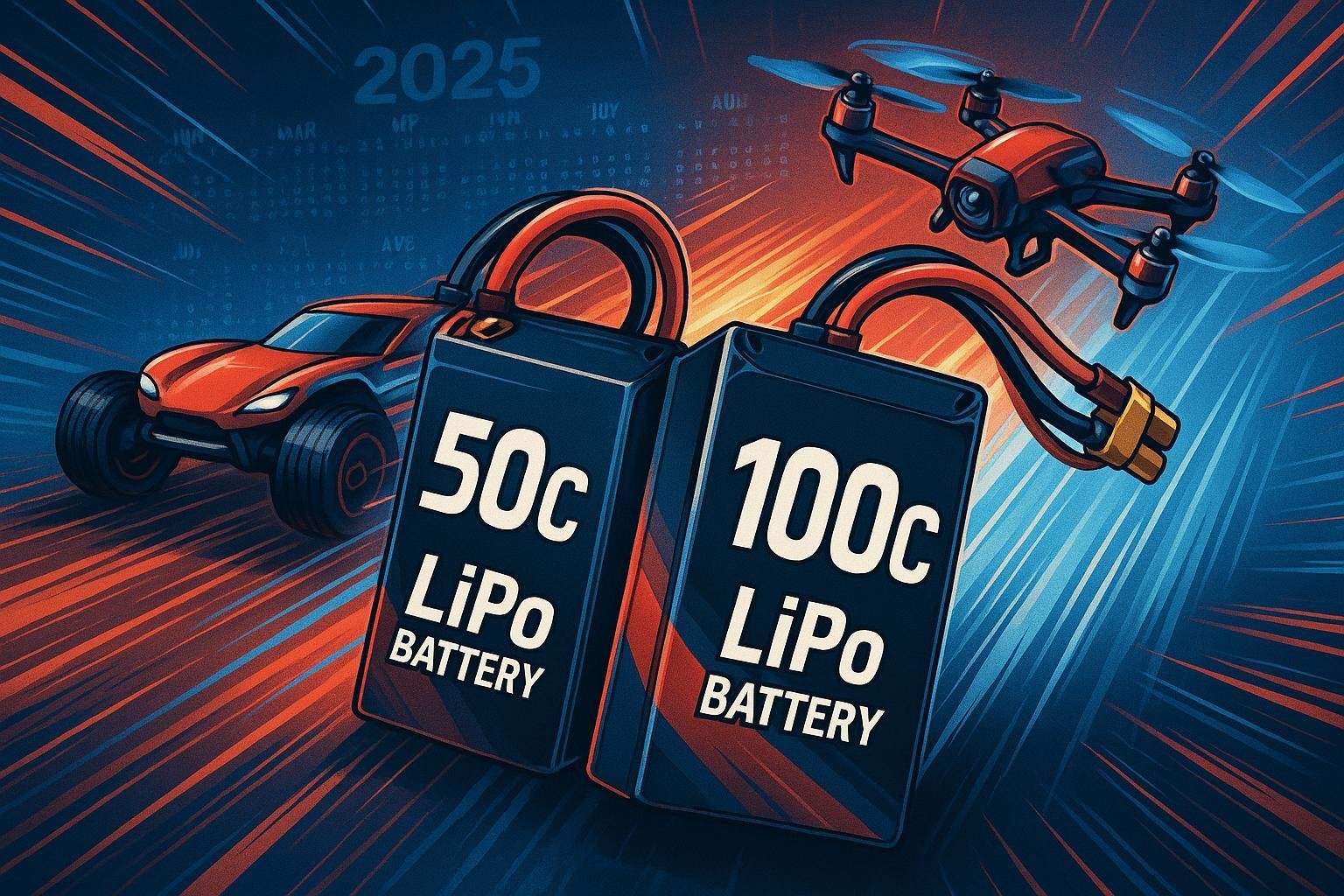
If you’re deep into RC—whether cars, trucks, drones, or planes—the C rating debate hits home: does jumping to a 100C LiPo truly deliver more punch, runtime, and race wins versus its trusted 50C cousin? Or is it mostly marketing? In 2025, battery tech remains fast-moving and often confusing. Here, we cut through the hype and bring hard data, clear scenario advice, and RC community wisdom so you know exactly when a higher C rating earns its keep (and when it’s overkill).
LiPo Battery C Ratings 101 (Quick Refresh)
- What is C rating? It’s the maximum safe discharge rate for a battery, calculated as capacity × C rating. For a 5000mAh (5Ah) pack, 50C means up to 250A output, 100C means up to 500A (Grepow: LiPo C Ratings guide, 2024).
- Pourquoi c'est important : Higher C allows for stronger acceleration, stable voltage under heavy loads (think race launches, punchy throttle), but may add cost, weight, and heat.
2025 Bench & Field Test Insights
- Voltage Sag & IR: RC club field testing and reviewer consensus show 100C batteries do maintain higher voltage and lower internal resistance (IR) under full throttle compared to 50C. The result: snappier acceleration for racing, less voltage drop, and reduced heat (Oscar Liang: LiPo Battery Guide, 2025).
- Cycle Life & Heat: Pushing either to their max shortens lifespan, but 100C packs tolerate aggressive use better; however, excessive abuse can cut cycles short regardless of rating (Enerforce RC Battery Guide, 2025).
Making the Call: C Rating vs RC Scenario
Decision isn’t one-size-fits-all. Here’s how real owners and tech results match up for common setups:
| Vehicle Type | Driving Style | Recommended C | What Actually Happens |
|---|---|---|---|
| 1/8 Race Car | Competitive racing | 100C | Maximum punch, top speed, stable voltage |
| 1/10 Basher | Casual/bashing | 50C | Adequate power, less heat, often longer run |
| RC Plane | Aerobatics/racing | 100C | Sharp maneuvers, voltage holds in turns |
| RC Plane | Gentle flying | 50C | Light weight, more endurance, cooler running |
| FPV Drone | Racing/freestyle | 100C | Instant thrust, stability, less voltage sag |
| FPV Drone | Photography/exploring | 50C | Extended flight times, smooth handling |
| Rock Crawler | Trail/scale driving | 50C | Sufficient torque and runtime, more cycles |
Real talk from the pits: “My buggy jumps better with 100C, but for backyard bashing, I see no difference—except my wallet feels it,” says a club racer from ArrmaForum (RC Forums: Arrma, 2025).
Price Breakdown: 50C vs 100C in the 2025 Market
Recent years brought price compression—100C packs are only 5–15% pricier than mainstream 50C options, depending on size and brand. Data from popular retailers (Amain Lectron Pro Listings, 2025, HobbyKing Turnigy Rapid 100C, 2025):
| Pack | Cells | Capacité | C Classement | Typical Price (USD) |
|---|---|---|---|---|
| Lectron Pro | 4S | 5200mAh | 50C | $89.99 |
| Ovonic (2S) | 2S | 5200mAh | 50C | $22.70 |
| Turnigy Rapid | 4S | 5000mAh | 100C | $22.99 |
| Firework Carbon | 4S | 5300mAh | 120C | $65.00 |
Prices may overlap more in 2025 due to increased competition; make sure to check cycle life and user ratings before buying.
C Rating Inflation: What the Specs Really Mean
Not all C ratings are created equal. Manufacturers often inflate numbers. Two 100C batteries from different brands can perform very differently. Independent RC testers (like Oscar Liang) routinely find real discharge rates 20–40% lower than label—so choose established brands and look for independent IR/discharge reviews (Oscar Liang: LiPo Battery Test Insights, 2025).
Safety First! Handling High-C LiPo Packs
- Storage: Always use LiPo-safe bags, fireproof cans; avoid leaving fully charged packs in cars or garages in summer.
- Charging: Never charge on flammable surfaces; stick to smart chargers, and never exceed recommended charge rate.
- Heat Management: Higher C packs run hotter—let them cool before recharging, and regularly check for puffiness or swelling.
- Cycle Care: Both ratings last 200–500 cycles if well cared for, but aggressive high-C racing can decrease longevity. Casual use with 50C extends life (Grepow: LiPo Safety, 2024).
Myth-Buster: Do You Really Need 100C?
- For competitive club racing, big brushless setups, FPV drone freestyle: YES, especially in extreme heat or with high-draw ESC/motors.
- For bashing, crawling, backyard play, scale models, and most beginner setups: 50C is sufficient—greater value, longer runtimes, less risk of heat/puffing.
- If your wallet’s tight: Don’t pay extra for C unless you can feel the difference in punch or speed—100C helps only if your ESC/motor and driving style demand it.
Decision Checklist (2025 Edition)
- Match battery to load: Check your motor’s peak amp draw (datasheet/manuals). If it peaks below 200A, 50C is likely fine; pushing 250A+, look for 100C.
- Prioritize runtime or power: Racing? Go 100C. Endurance or casual—stick 50C.
- Consider battery weight: Higher C sometimes = heavier packs; can affect handling in small scales or aircraft.
- Trust user reviews & field data: RC forums, club Facebook groups, and independent testers outsmart label hype.
- Budget and longevity: Entry-level builds benefit from 50C; scale up only as needs grow.
Final Take: Club Veteran’s 2025 Perspective
Don’t fall for numbers alone—buy what you can actually use! For most everyday RC drivers or drone pilots, a well-made 50C delivers all the punch you’ll notice and gives longer life at a competitive price. If you’re racing at the edge, flying FPV freestyle, or running high-amp brushless, the 100C advantages are real—but only if you run hard enough to use them.
Further Reading & Authoritative Sources:
- Grepow: LiPo C Ratings Explained (2024)
- Oscar Liang: Independent LiPo Battery Test Guide (2025)
- RC Forums: Arrma Club Discussion (2025)
- Enerforce RC Battery Guide (2025)
Stay safe, race smart, and may your voltage never sag!

